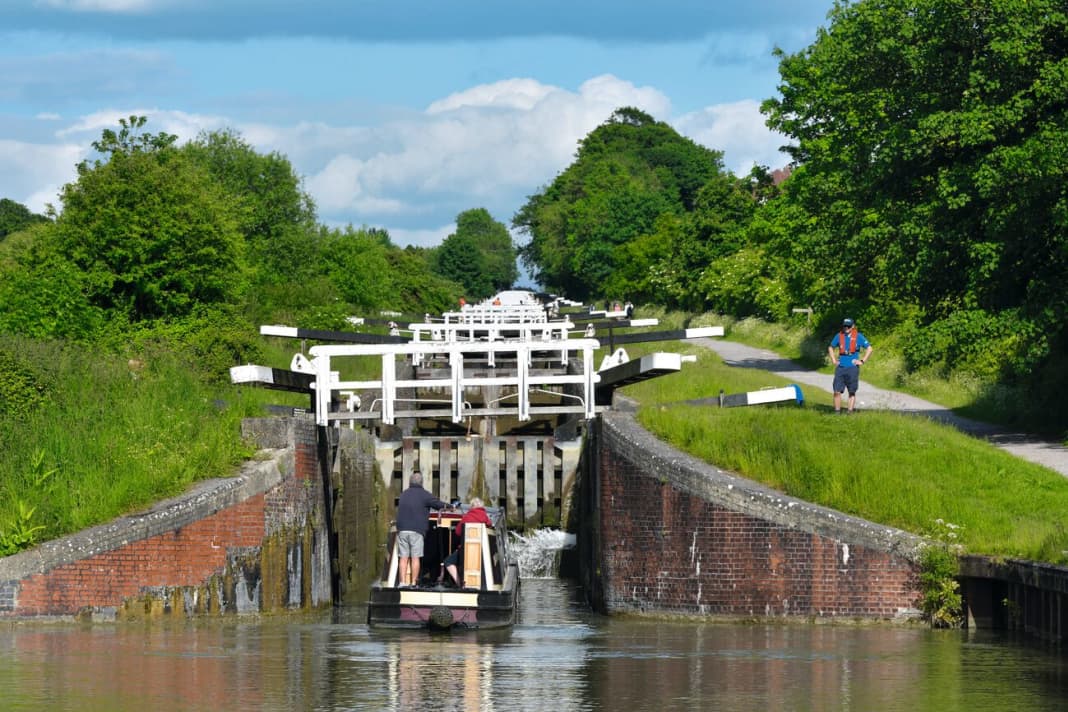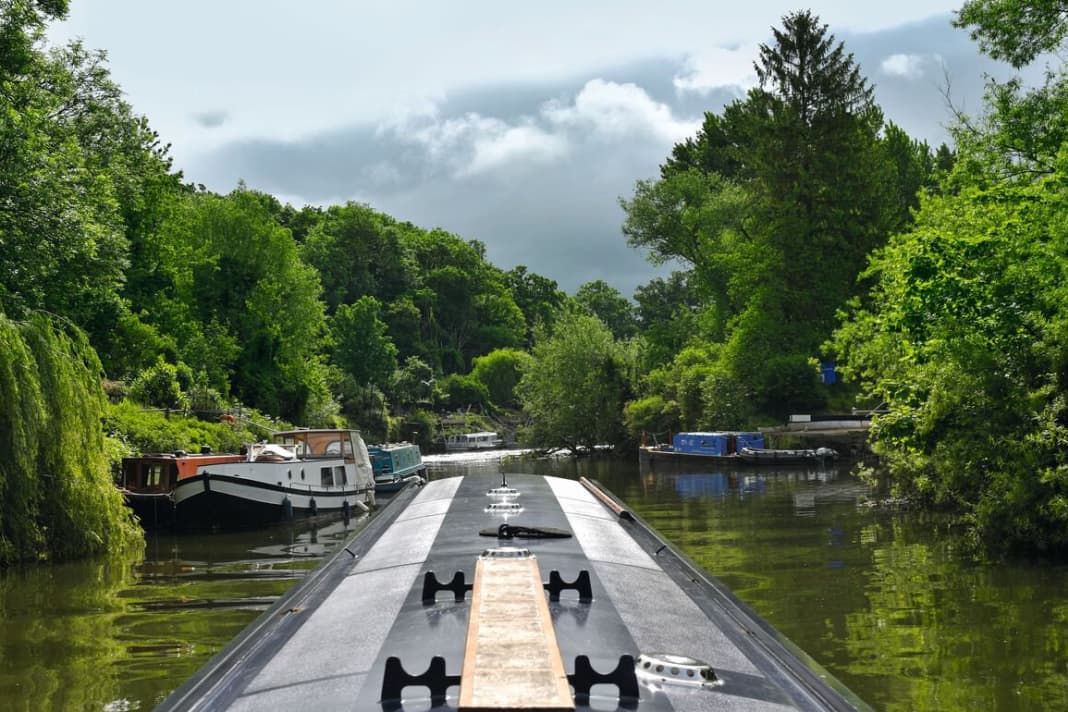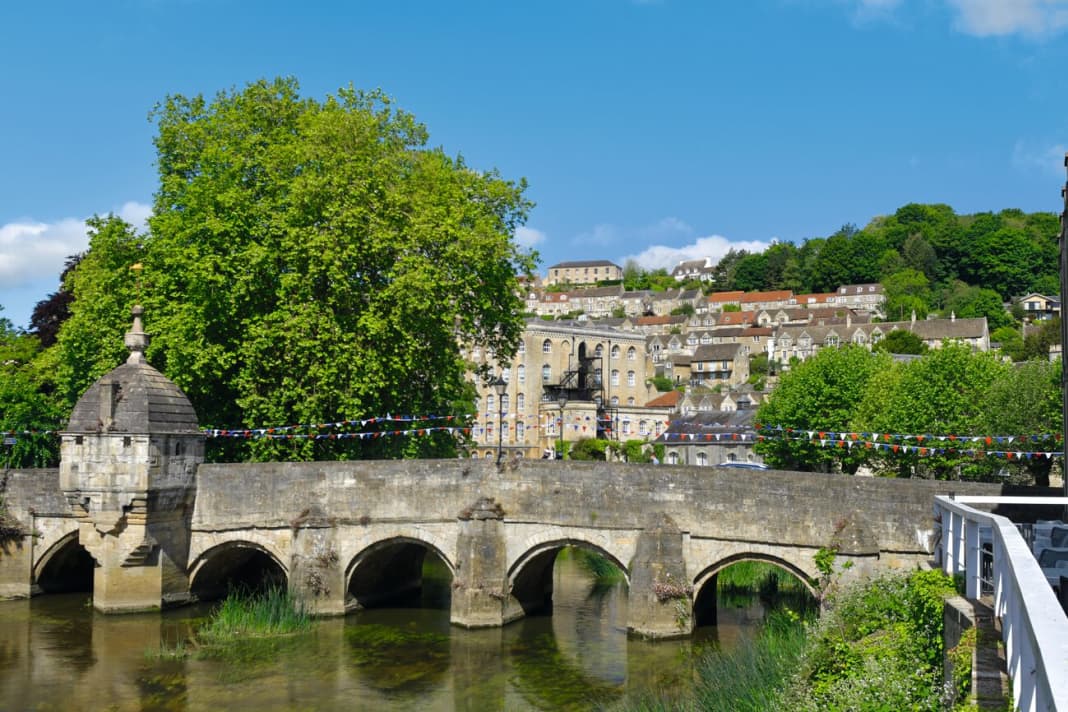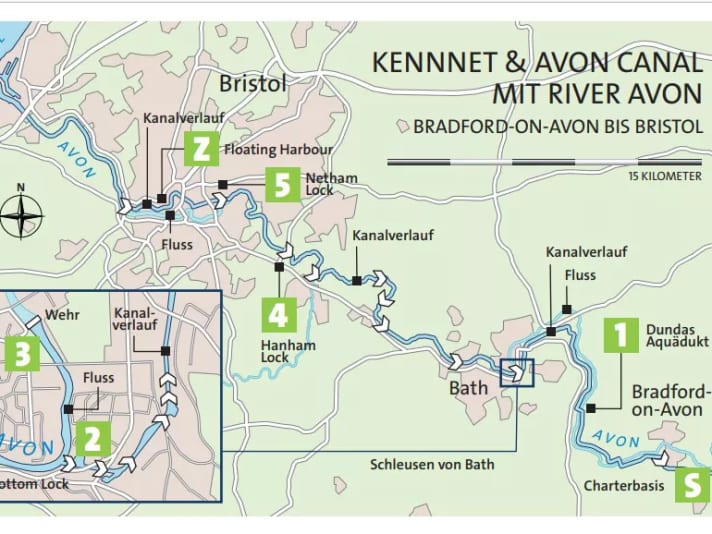





"Forty minutes", is the taxi driver's estimate for the journey from Bristol Airport to Bradford-on-Avon. The route leads along small, winding roads. The landscape is green and dotted with rolling hills. This makes it clear that our narrowboat cruise here in the south-west of England is no Sunday treat for lock-haters. Especially as the locks - or as the British say: locks - all date back to the early days of English canal construction and are operated by hand. When we arrive, we pay £65 for the transfer. In return, the driver not only brings our luggage to the boat, but also drives us to the nearest supermarket.
"The boat is ready", is how Tim greets us on our return. He asks whether we just want to enjoy nature on the trip or whether we are also interested in art and culture. We decide in favour of the latter. "Good choice," smiles the base manager. "Then take the Kennet and Avon Canal towards Bristol. That's a few miles longer than in the opposite direction. But there are around 60 fewer locks." The briefing for the boat is done quickly. Our floating motorhome is an easy-to-operate narrowboat, just under 16 metres long and around two metres wide. The boat looks - sorry, Brits, no offence meant - as if an old railway carriage had been brightly painted, the wheels removed and the bottom sealed. There are no gangways, fender rails or bow thrusters. "Don't worry," Tim assures us, "nobody's ever had any problems with that." He says and wishes us a safe journey.
Boats are lined up endlessly on the shore under a canopy of green leaves
The medieval town of Bradford-on-Avon with its honey-coloured sandstone cottages lies astern. I stand in the cockpit, tiller in hand, and chug along at three miles per hour (measured by sat nav app). On the shore, under the green canopy of tall alders and ash trees, the boats are lined up endlessly. Some are adventurous custom-built constructions, others are chic steel displacers of Dutch origin, but the majority are beautifully pimped narrowboats with or without a vegetable garden on the roof. On the waterway, which opened in 1810, the floating vessel is a living room, lounge and pub all in one. Barbecue clouds are curling, beer is flowing, in short, it's the weekend. What could be more natural than to revive the golden age of Victorian picnic culture on this historic canal? We drive to the Dundas Aqueduct, which Tim recommended as a place to spend the night.
At seven o'clock sharp, the train from Bristol to Southampton rouses me from my sleep. Around twelve metres below the 200-year-old aqueduct, the former death knell of British canal shipping thunders through the idyllic Avon valley at a crazy speed. It used to take an average of five days to transport coal from Bristol to the energy-hungry capital London by narrowboat. Today, the fast train covers the 190 kilometre route in 69 minutes. But narrowboating is no longer a question of time, it's simply cult. With this in mind, I calmly make myself a coffee.
On the water over the water - The Dundas Aqueduct to Bath
While the gas cooker hisses, the first paddlers pass the aqueduct. In the boat behind me, just before the mouth of the small Somerset Coal Canal into the Kennet & Avon Canal, an elderly lady in a Laura Ashley dress is looking after her onboard cats. The older of her companions, she tells me, is called Elizabeth I, the younger, how could it be otherwise, Elizabeth II.
Narrowboating is no longer a question of time
1 p.m.: After breakfast and small talk with the neighbouring crews, we are underway again. Two Lilliputian swing bridges and a cool cider later (which we treat ourselves to in the beer garden of the George Inn, a former monastery), we have reached the top lock in Bath, the first of a total of six. Unfortunately, the view of the picture-book city, a UNESCO World Heritage Site, with its Georgian residential palaces and Roman baths is obscured by trees. We work our way down the valley, lock by lock, until after an hour and a half and around 20 metres down, the last gate releases us onto the River Avon.
We take a short detour upriver towards the historic city centre to Bath Abbey. A few beats behind the Gothic church, where England's first king was crowned in 973, we turn in front of the Pulteney Weir, take a look at the neighbouring Empire Hotel - 100 years ago something like the Adlon of Bath - and moor a good half a mile downstream a stone's throw behind the Churchill Bridge.
No other English town basks in the glamour of more spectacular cultural and architectural attractions than this former sanctuary of the Celtic goddess Sulis, whose hot mineral springs were also appreciated by the Romans until their empire collapsed.
Impressions from a narrowboat trip:






Bath sank into a deep slumber, only to be kissed awake again by Queen Anne Stuart at the beginning of the 18th century. The bath attendants may know to what extent the healing springs were able to alleviate her gout at the time, but the Queen's visits catapulted the small town of 3,000 inhabitants to the top of the list of British high society spa resorts in no time at all. The magnificent and splendid buildings soon sprang up like mushrooms. The architect John Wood and his son of the same name were in charge. Their arched luxury properties were highly sought after. Those who could afford it lived and cured in Bath, indulged in card games, met for a tête-à-tête or danced the night away. Moral misdemeanours and their consequences were part of the package. And so the (probably more than nasty) rumour persists to this day that Queen Mary II's pregnancy had less to do with the healing powers of the springs than with the virility of her spa shadow.
But Bath was not only the Mecca of the moneyed and high nobility. A certain Admiral Lord Nelson was also a regular visitor. The guarantor of the Royal Navy's unrestricted rule over the world's oceans cured his numerous naval wounds here. According to legend, he stayed in a guest room in what is now the Crystal Palace pub. We first take a look at the excavations of the Roman baths and then turn our attention to the pub. On the recommendation of the waiter, we order shepherd's pie, the traditional casserole with minced lamb, potatoes and vegetables. "Cold or warm?" The waiter seems to read the horror from the tip of my nose. Warm beer? "Try it", he recommends and conjures up a room-temperature bottle on the table. Indeed, our taste buds can only enjoy the delicious coffee and chocolate flavours of the deep dark craft brew when it is not chilled.
After all, politeness is as natural here as drinking tea
Tuesday morning: We treat ourselves to a ticket for the Thermae Bath Spa, enjoy the view from the rooftop pool of the wellness centre and then fill the fridge in our galley with Scottish salmon and - noblesse oblige - French champagne. Around 1 p.m. it's time to cast off. We push past meadows and tranquil meadows at a leisurely pace. There are hardly any boats on the water, the banks belong to herons, swans and ducks. Every now and then a village peeps out of the greenery, and occasionally we come across canoeists or stand-up paddlers.
Three locks further on, The Jolly Sailor pub serves regional cuisine and - the ex-Empire sends its regards - Indian curries. The rustic quarry stone building with its beer garden right by the Salford lock is around 300 years old. A narrowboat is already moored in the chamber. It belongs to Mr and Mrs Smith. They come from Birmingham and, like every summer, have been travelling for months in their blue-painted traditional boat. Of course, they wait until we have also arrived. After all, politeness in Great Britain is as much a matter of course as drinking tea.
Hanham Look: It's just after 7 pm. The moorings around the lock and the weir of the same name are already full. Should we carry on and spend the night on the riverbank on the way to Bristol? What would have been common practice on the previous route is no longer an option: firstly, there are no moorings on the next six kilometres. And secondly, the lower reaches of the River Avon are tidal. So we have to call Netham lock and find out the current water levels and the berth situation in Bristol town harbour. So I reach for my mobile phone and after a call forwarding I have the lock keeper soon on the line so that I can tell him about our situation. "No problem, is the answer. "You just stay where you are today and then leave for Bristol tomorrow at seven o'clock sharp."
Highlights from the south of England in pictures:






This is how it's done - in extremely modest weather: It's raining cats and dogs, is what they say here when St Peter pours out the heavens. As luck would have it, the heavenly door closer is not having his best day today. It's raining heavily as we enter the Netham lock. I sprint to the lock keeper's cottage, the man immediately remembers our phone call yesterday, enquires about the length of our boat and then issues me with 37.15 lbs. harbour charges, i.e. harbour dues, on account, insurance included. Back on board, with umbrella in the right hand and tiller in the left, we continue on the water towards the city centre. The city, which has been praised with a Baedecker star and has a population of just under half a million, does not present anything spectacular for the time being.
This is changing with the passage of Temple Bridge. Instead of plain suburban neighbourhoods, chic brick flats are now springing up. Living and working on the waterfront, a hint of Hamburg's HafenCity lies over the Quays. Then the Prince Street Bridge comes into view. However, access to the centre of the floating harbour is currently out of order, The 140-year-old swing bridge is currently being repaired. We already fear that this is the end of the line for us. But according to our base manager Tim, the clearance height should be sufficient for us even when the bridge is closed. So head down and ... We actually pass the bridge's listed iron girders without any ifs or buts.
In one fell swoop, the time machine transforms the here and now into a mix of yesterday and tomorrow
Life pulsates to the right and left of the waterfront, with students, artists and creatives holding hands. The harbour itself is a blueprint of its history. On the port side, just behind the Prince Street Bridge, lies the passenger steamer "Balmoral", launched in 1947, followed by historic cranes, hissing steam locomotives and the Fairbairn Steam Crane. This steam-powered Hercules was built by Stothert & Pitt in Bath in the mid-1880s and could lift more than 35 tonnes. The powerhouse did not make a career for itself. It took time and a lot of money before it flexed its muscles. This sealed the Goliath's fate. Like the narrowboats, it fell victim to technical progress. After just a few years, its electrically powered counterparts sent it into retirement.
Cranes, steamships and a replica of the "The Matthew", which was once used by settlers to sail to the New World: We are already excited, but then we stand in front of the absolute star of the Floating Harbour, the SS "Great Britain". Launched in Bristol in 1843, the ship was, there is no other way to put it, a technical revolution in its day. Contrary to everything that naval architects thought of at the time, the 98 metre long, 3670 tonne passenger liner not only had an iron hull and watertight bulkheads, but also a propeller at the stern instead of the side paddle wheels that were common at the time but inefficient in rough seas.
One feat of engineering follows the next at the end of our trip. Tomorrow, we could still take on the Clifton Supension Bridge. Completed in 1864, the chain bridge across the Avon is a proud Bristol landmark. However, before we head back on board our narrowboat for the last night, the art of brewing takes precedence over the art of building once again: we head to the Llandoger Trow. And the pub in King Street, which opened in 1664, is certainly not without its flair. According to legend, fifteen (!) ghosts live here.
The pub is also said to have been the literary cradle of the world-famous stories "Robinson Crusoe" by Daniel Defoe and Robert Louis Stevenson's "Treasure Island". Perhaps the authors used the beer on tap to fuel their imaginations: Adnams Southwold Ghost Ship. We want to try that too. After all, we want to get a few logbook lines down on paper on the last evening. Let's see what the ghost ship drink dictates into the pen...

The top 3 in the district
1 Bath: Ancient Roman baths, Victorian aristocracy and magnificent Georgian architecture make the UNESCO World Heritage Site an absolute "must see" (www.visitbath.co.uk)
2 Bristol: Its proud maritime history extends far beyond the harbour. It is also home to a lively street art, music and pub scene (www.visitbristol.co.uk)
3 Dundas Aqueduct: Crossing another body of water on a canal bridge doesn't happen every day - and on a historic structure at that. A special experience

Cruising stages
S Bradford-on-Avon Marina- Dundas aqueduct: 7.5 km
- Dundas Aqueduct- Bath (Bottom Lock): approx. 9.0 km
- Bath (Bottom Lock)- Bath jetty (Empire Hotel): approx. 1.5 km
- Bath jetty- Hanham Lock: approx. 15.5 km
- Hanham Lock- Netham Lock: 6.0 km
- Netham Lock- Bristol city harbour: 4.5 km
Z Bristol city harbour Total distance: approx. 44 km
Literature
Heron Maps: "Kennet & Avon Canal and River Avon" (in English). Map of the entire waterway from Bristol via Bradford-on-Avon to Reading at a scale of 1,50,000. 7 city maps at a scale of 1,12,500, nautical tips, tourist addresses and brief historical information. Published by Heron Maps, 3rd edition 2022; £5.99.
Canal Companion: "Kennet & Avon, River Thames. Oxford , Reading, Brentford" (in English). Detailed information and maps for the inland waterways from Bristol to Reading and from there via the Thames to Brentfort (near London) and Oxford. Pearson & Son, 3rd edition 2021, 96 p.; 11.95 pounds sterling.
OUR BOAT: Fair Winds type P4, year of construction 2019, length: 15.8 m, width 2.1 m, draught: 0.6 m, engine 44 hp, fuel tank: 280 l, water tank: 400 l. Equipment: heating, kitchen with gas cooker and oven, refrigerator with freezer compartment, 2 cabins with double berths, seating group in the foredeck that can be converted into a bunk, 1 wet room (pump toilet, shower). Weekly rates: from 1482 euros.
CHARTER: Fair Winds Yacht Charter Hamburg specialises in narrowboat cruises in Great Britain. The corresponding boats are between 14.3 m (47 ft) and 21.3 m (70 ft) long, have one to four cabins and can be sailed without a licence. The cruises start from nine bases, each with three to four routes. The length of the routes varies between approx. 70 km and approx. 310 km, the number of locks between 6 and 190. The galleys of the boats are fully equipped, bed linen, towels, final cleaning and combined hull/liability insurance are included in the price. Tel. 040 639 77 995, www.fairwindsyachtcharter.de
Nautical information
THE REVIER In 1810, the 92 km long Kennet & Avon Canal between Bath and Newbury was opened as part of the 140 km long navigable link (105 locks) from the seaport of Bristol to the Thames. The project was not economically worthwhile. The railway quickly made the waterway unprofitable. The canal was due to be closed in the mid-1950s. But things turned out differently. Initiatives were launched to renovate it, and after decades of restoration work, the historic waterway was handed over by Queen Elizabeth II on 8 August 1990 for its current use as a recreational waterway. The water level of the River Avon is influenced by the tides downstream of Hanham Lock, the harbour and its approach in Bristol are tide-free between Netham Lock in the east and the Cumberland Basin in the west of the city, in Avonmouth, today the Port of Bristol at the mouth of the Avon into the Bristol Channel, the tidal range easily reaches double figures.

